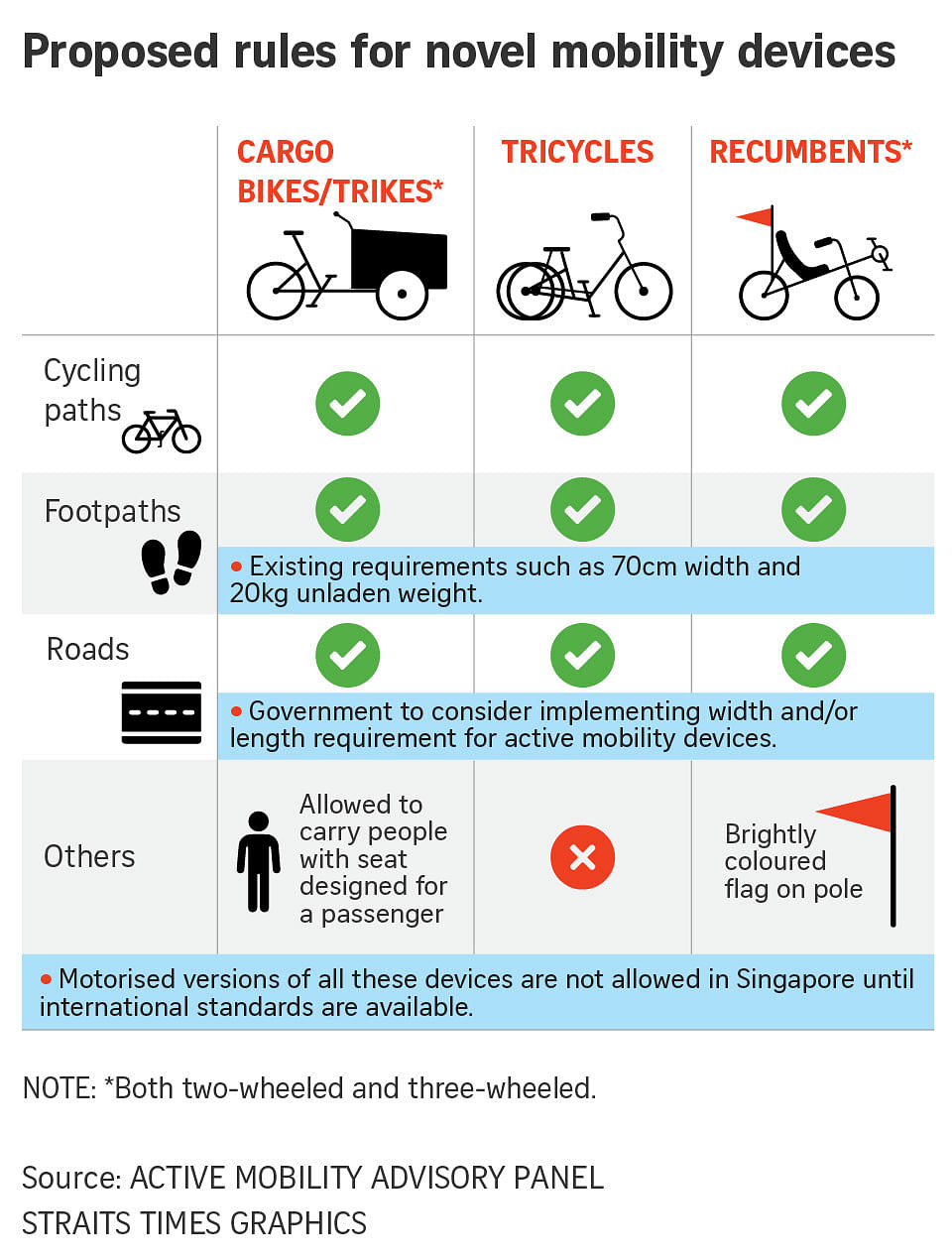SINGAPORE – All active mobility devices allowed to be ridden on roads in Singapore should be subject to a width or length limit to limit obstruction.
In a report submitted on Monday to the Ministry of Transport, the Active Mobility Advisory Panel (Amap) said mobility devices that are excessively wide or long may obstruct other road users as these devices tend to be slower-moving, less manoeuvrable and harder to overtake.
To prevent the proliferation of such devices, the 16-member advisory panel – which reviewed the rules governing their use – recommended that the Government impose width or length criteria for all active mobility devices used on roads here.
These devices include conventional and electric bicycles, as well as more novel devices such as cargo bicycles – relatively larger bikes with a storage area – and recumbents, which place the rider in a reclining position.
These newer devices have already been seen on Singapore’s streets, but they are not yet widespread.
The Land Transport Authority said it is aware of at least 250 cargo bicycles, cargo tricycles, rider-only tricycles and recumbents in use in Singapore.
This is based on engagements with interest groups and cleaning companies.
However, given the growing popularity of these devices in European and North American cities, Amap said its latest recommendations are focused on regulating such devices to maintain path and road safety, while also ensuring the rules are consistent.
For instance, the panel noted that under current rules, cargo bicycles and two-wheeled recumbents are allowed on both paths and roads, but rider-only tricycles and three-wheeled recumbents are allowed only on paths, even though the devices are all similar.
Thus, the panel proposed allowing rider-only tricycles and three-wheeled recumbents to be ridden on roads, and recommended that the Government should make clear that cargo tricycles are allowed on both paths and roads as well.
However, the panel also proposed that all active mobility devices used on footpaths and cycling paths be subject to prevailing size and weight limits. This is to ensure there is sufficient space between path users for safe passing or overtaking, and reduce the risk of serious injury in the event of a collision.
Currently, all active mobility devices used on footpaths and cycling paths cannot be wider than 70cm and cannot weigh more than 20kg.
The panel said most cargo tricycles and recumbents in the market exceed the 70cm width limit and cannot be used on paths. It also noted that some cargo bicycles, cargo tricycles, rider-only tricycles and recumbents in the market today exceed the 20kg weight limit and cannot be used on paths.
It suggested the Government consider reviewing the weight limits set for active mobility devices on public paths.
It also recommended that motorised cargo bicycles, tricycles and recumbents continue to be banned from paths and roads here.
This recommendation can be reviewed again when recognised international standards are available, Amap said.
The panel also noted concerns that recumbent bikes with lower profiles may not always be visible on the roads, especially if they are in a motorist’s blind spot.
It suggested requiring recumbent bikes to have a brightly coloured flag installed on a pole of a reasonable height when used on roads here.
Amap said it studied overseas practices and held a series of public consultations, including several focus group discussions, as part of its review.
Participants in these discussions included pedestrians, motorists, bus drivers, food delivery riders, cargo bicycle and tricycle riders from cleaning companies and recumbent riders.
While these participants had concerns that novel mobility devices could lead to congestion on paths or added difficulty for vehicles overtaking them on roads, they also recognised the value of such devices, Amap said.
For example, the panel noted that cargo bicycles could be a substitute for cars in short-distance journeys. Meanwhile, tricycles provide more stable riding options for seniors, while recumbents cater to those with mobility issues or who are unable to sit upright because of medical conditions.
“The panel believes that the recommendations strike a balance between facilitating more types of devices to be used on paths and roads, with accompanying new rules to ensure the safety of all path and road users,” Amap said.
It added that the latest recommendations, if accepted by the Government, should be introduced as soon as possible. However, there should also be a transition period to raise public awareness of the new rules and guidelines.
In a Facebook post on Monday, Transport Minister S. Iswaran said his ministry will study the panel’s recommendations carefully.
Amap also urged cargo bike and recumbent-bike interest groups to help with public education and outreach efforts.
Cycling enthusiasts The Straits Times spoke to welcomed the latest Amap proposals, though some felt the limits placed on these devices could be relaxed further.
Mr Brendan Goh, 40, who started using a recumbent tricycle two years ago due to issues with his knees, said being able to go on the road would make the cycling experience much smoother.
“On footpaths and park connectors, it can be pretty difficult because there are a lot of obstructions and the path can be quite narrow,” the e-commerce manager added.
He hopes the authorities will revise the 70cm width and 20kg weight limit for footpaths and cycling paths to allow more cargo bikes, tricycles and recumbent bikes to be used.
“If some recumbent tricycles aren’t allowed on park connectors, that may discourage seniors and people with mobility issues from using them because not everyone is comfortable going on the road,” the e-commerce manager added.
Mr Stefan Ansorge, 53, who has been importing cargo bikes to sell here since 2015, said he welcomes the proposed framework for such devices as the rules on their use are not clear.
While cargo bikes are still a niche product, Mr Ansorge said interest in them has grown, and he now sells about 10 to 20 a year, compared with three to four when he first started.
“I’m happy that instead of banning the cargo bike or restricting it to meaninglessness, the authorities have acknowledged this vehicle can contribute to the quality of life in Singapore,” the German said.
“That doesn’t mean I am happy with every detail. But this is a starting point, and we can work from here. In the long run, it is important that Singapore slowly builds up the infrastructure for vehicles like this.”



